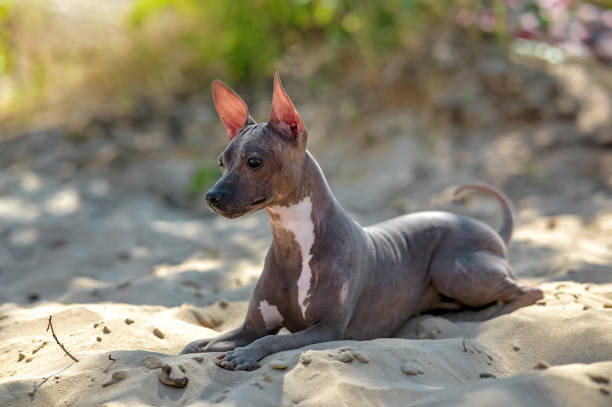American Hairless Terrier

Breed History:
The American Hairless Terrier is a relatively recent and unique breed that originated in the United States in the 1970s. It descended from the Rat Terrier when a hairless puppy named Josephine was born in a litter. Recognising the rarity and potential of this genetic trait, breeders began selectively breeding for the hairless characteristic. Over time, this led to the development of the American Hairless Terrier as a distinct breed.
In 2016, the American Kennel Club (AKC) officially recognised the breed, making it the first hairless breed to originate in the U.S. Today, the American Hairless Terrier is admired for its lively spirit, intelligence, and hypoallergenic qualities, making it a great companion for those with dog allergies.
Height: 30-41 cm
Weight: 5-12 kg
Size – Small-Medium
Life Expectancy: 14–16 years

Breed Appearance:
The American Hairless Terrier is a small to medium-sized, well-muscled dog with a sleek and alert appearance. As the name suggests, it typically has no coat, although a coated variety exists. The hairless variety has smooth, warm skin that may be spotted or solid-colored, with shades ranging from pink and black to brindle and sable.
It has expressive, almond-shaped eyes, large, erect ears, and a tapering tail. The coated version has a short, dense coat. Overall, the breed gives off an energetic and intelligent vibe, with a graceful yet athletic build suited to active lifestyles.
Breed Type – Companion/Family:
The American Hairless Terrier is an affectionate and spirited companion dog. It is known for forming close bonds with its family and thrives on interaction and play. This breed is alert and makes a good watchdog, though it is rarely aggressive. It tends to be social with people and can get along with other pets if properly introduced.
Its friendly and curious temperament makes it well-suited for families, including those with children. However, due to its high energy and prey drive, it should be supervised around small animals like rodents or birds.

Training:
Intelligent and eager to please, the American Hairless Terrier is generally easy to train, especially when started at a young age. It responds well to positive reinforcement methods such as treats, praise, and play. Harsh or inconsistent training can cause the dog to become stubborn or disengaged.
Early socialisation is important to ensure the dog is comfortable with a variety of people, environments, and other animals. It enjoys learning new tricks and can excel in obedience, agility, and other dog sports.
Health & Care:
The American Hairless Terrier is a robust and healthy breed with minimal hereditary health problems. However, its hairless skin requires special care:
-
Prone to sunburn—needs sunscreen or clothing when outside
-
Susceptible to cuts, abrasions, and dry skin
-
Possible dental issues due to a smaller jaw size in some lines
Regular vet check-ups, a balanced diet, and protection from extreme temperatures are essential. The breed does not tolerate cold weather well and may need coats or sweaters when temperatures drop.

Living Conditions:
Adaptable and versatile, the American Hairless Terrier can thrive in a variety of settings, from apartments to larger homes, as long as it receives adequate exercise and attention. Its small size makes it ideal for urban living, and it prefers to be indoors due to its sensitive skin.
Because it bonds closely with its family, it does not do well when left alone for long periods. A secure indoor environment with access to short, supervised outdoor play sessions is ideal for this breed.
Exercise:
Despite its small size, the American Hairless Terrier is lively and active. It requires daily physical and mental stimulation to prevent boredom and behavioural problems. Walks, play sessions, and interactive toys will help burn off energy and keep the dog satisfied.
This breed enjoys structured activities like agility, obedience training, and puzzle games. While it doesn’t need excessive exercise, it thrives in environments that encourage activity and interaction.
Grooming:
Grooming needs are minimal for the hairless variety, but skin care is crucial. Regular wiping with a damp cloth or occasional baths with a gentle, non-irritating dog shampoo will keep the skin clean. Sunscreen or protective clothing is needed for outdoor activities to prevent sunburn.
For the coated variety, brushing once a week is sufficient. Regardless of coat type, routine nail trimming, ear cleaning, and dental care are necessary to maintain overall health and hygiene.

Advantages:
-
Hypoallergenic and low-shedding, ideal for allergy sufferers
-
Intelligent and eager to please, making training easier
-
Affectionate and loyal companion with strong family bonds
-
Generally healthy and long-lived breed
-
Minimal grooming requirements
-
Good watchdog without being overly aggressive
Disadvantages:
-
Hairless skin is prone to sunburn, dryness, and injury
-
Requires protective clothing or sunscreen in extreme weather
-
May be stubborn or independent without consistent training
-
High prey drive can make it challenging with small animals
-
Doesn’t tolerate being left alone for long periods
-
Can be noisy or reactive if not properly socialized

